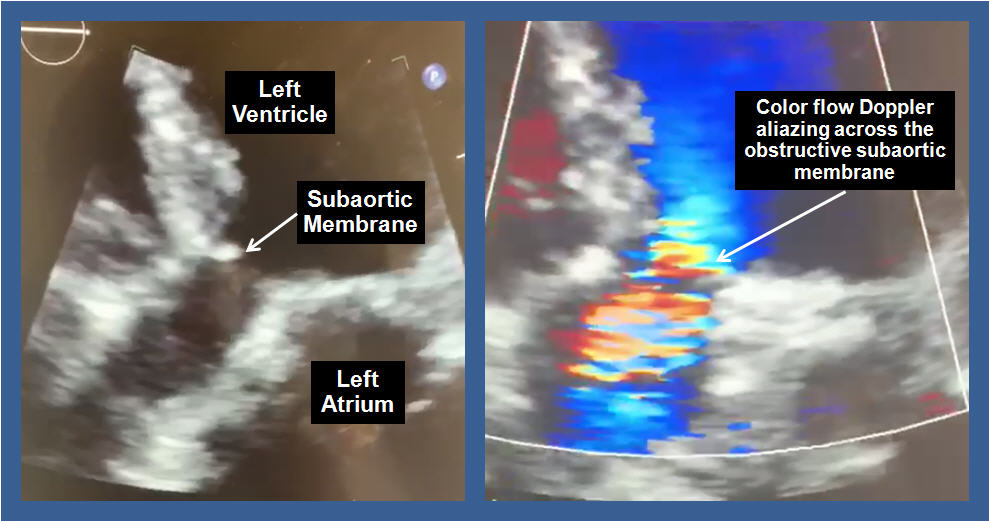September 2019 Issue
ISSN 2689-291X
ISSN 2689-291X
Challenging Images
Subaortic Membrane! Obstruction with Aliazing!
Description
The figure on the left shows an obstructive subaortic membrane seen below the aortic valve on the septal aspect of the left ventricular outflow tract (LVOT). Color flow Doppler across the LVOT reveals color aliazing across the subaortic membrane, indicative of increased velocities due to obstruction.
The overall incidence of subaortic stenosis is about 6.5% of all adult congenital heart disease. This includes a variety of anatomic configurations, including a discrete membrane below the aortic valve (most common), a thick fibromuscular ridge and a narrow fibromuscular tunnel along the LVOT [1].
Echocardiography is often the preferred diagnostic modality; however, since the condition can sometime mimic hypertrophic cardiomyopathy, a multimodality imaging approach may be needed to better differentiate these conditions [2].
Subaortic stenosis can cause symptoms of congestive heart failure which resemble valvular aortic stenosis [3]. The traditional approach to symptomatic patients has been surgical resection, which overall has resulted in adequate relief of the gradient with low mortality [4]. For high surgical risk patients, novel transcatheter therapies have been reported and may be an alternative [5].
References:
Authors:
Sarina Sachdev, M.D.
Cardiology Fellow
University of South Alabama
Mobile, AL
Landai Nguyen, D.O.
Cardiology Fellow
University of South Alabama
Mobile, AL
Hassan Tahir, M.D.
Cardiology Fellow
University of South Alabama
Mobile, AL
Abimbola Shofu, M.D.
Staff Cardiologist
Genesis Healthcare System
Zanesville, OH
Bassam Omar, M.D., Ph.D.
Professor of Cardiology
University of South Alabama
Mobile, AL
The figure on the left shows an obstructive subaortic membrane seen below the aortic valve on the septal aspect of the left ventricular outflow tract (LVOT). Color flow Doppler across the LVOT reveals color aliazing across the subaortic membrane, indicative of increased velocities due to obstruction.
The overall incidence of subaortic stenosis is about 6.5% of all adult congenital heart disease. This includes a variety of anatomic configurations, including a discrete membrane below the aortic valve (most common), a thick fibromuscular ridge and a narrow fibromuscular tunnel along the LVOT [1].
Echocardiography is often the preferred diagnostic modality; however, since the condition can sometime mimic hypertrophic cardiomyopathy, a multimodality imaging approach may be needed to better differentiate these conditions [2].
Subaortic stenosis can cause symptoms of congestive heart failure which resemble valvular aortic stenosis [3]. The traditional approach to symptomatic patients has been surgical resection, which overall has resulted in adequate relief of the gradient with low mortality [4]. For high surgical risk patients, novel transcatheter therapies have been reported and may be an alternative [5].
References:
- Devabhaktuni SR, Chakfeh E, Malik AO, et al. Subvalvular aortic stenosis: a review of current literature. Clin Cardiol. 2018 Jan;41(1):131-136.
- Qureshi A, Awuor S, Martinez M. Adult presentation of subaortic stenosis: another great hypertrophic cardiomyopathy mimic. Heart Lung Circ. 2015 Jan;24(1):e7-e10.
- Carr JA, Sugeng L, Weinert L, et al. Images in cardiovascular medicine. Subaortic membrane in the adult. Circulation. 2005 Dec 6;112(23):e347.
- Ibrahim M, Kostolny M, Hsia TY, Van Doorn C, et al. The surgical history, management, and outcomes of subaortic stenosis in adults. Ann Thorac Surg. 2012 Apr;93(4):1128-33.
- Kamioka N, Patel A, Lerakis S, et al.Transcatheter Treatment of Subaortic Stenosis Via Transcaval Access. JACC Cardiovasc Interv. 2017 Apr 10;10(7):740-741.
Authors:
Sarina Sachdev, M.D.
Cardiology Fellow
University of South Alabama
Mobile, AL
Landai Nguyen, D.O.
Cardiology Fellow
University of South Alabama
Mobile, AL
Hassan Tahir, M.D.
Cardiology Fellow
University of South Alabama
Mobile, AL
Abimbola Shofu, M.D.
Staff Cardiologist
Genesis Healthcare System
Zanesville, OH
Bassam Omar, M.D., Ph.D.
Professor of Cardiology
University of South Alabama
Mobile, AL

